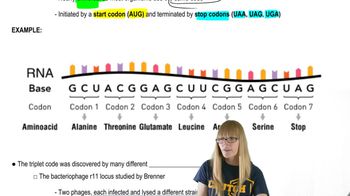Here are the essential concepts you must grasp in order to answer the question correctly.
Base-Substitution Mutation
A base-substitution mutation occurs when one nucleotide in the DNA sequence is replaced by another. This type of mutation can lead to changes in the amino acid sequence of a protein, potentially altering its function. Depending on the nature of the substitution, it can be classified as a silent, missense, or nonsense mutation, each having different effects on protein synthesis.
Recommended video:
Polypeptide Synthesis
Polypeptide synthesis is the process by which amino acids are linked together to form proteins, guided by the sequence of nucleotides in mRNA. This process involves transcription, where DNA is converted to mRNA, and translation, where ribosomes read the mRNA sequence to assemble the corresponding amino acids. Disruptions in this process, such as those caused by mutations, can lead to incomplete or nonfunctional proteins.
Recommended video:
Codon Recognition
Codon recognition is the mechanism by which ribosomes interpret the sequence of nucleotides in mRNA to determine which amino acids to incorporate into a growing polypeptide chain. Each codon, a sequence of three nucleotides, corresponds to a specific amino acid or a stop signal. If a mutation alters a codon to a stop codon prematurely, it can terminate polypeptide synthesis, resulting in a truncated protein.
Recommended video:






